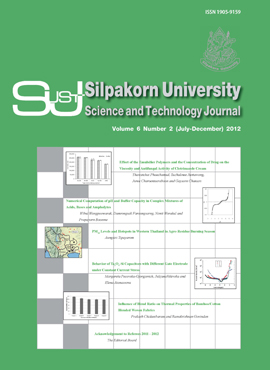Influence of Blend Ratio on Thermal Properties of Bamboo/ Cotton Blended Woven Fabrics
Main Article Content
Abstract
Thermal comfort characteristics of plain woven fabrics made out of 30s Nec cotton in warp and 30s Nec 100% bamboo, bamboo/cotton blended yarns in weft have been studied. The fabric characteristics such asair permeability, wicking, thermal resistance, relative water permeability related to comfort characteristicsare discussed. The experimental results show that 30s Nec cotton in warp and 30s Nec bamboo in weft plainwoven fabric exhibits higher air permeability when compared to other samples, 30s Nec cotton in warp and 30s Nec bamboo in weft plain woven fabric shows very low thermal resistance and higher wicking rate thanother samples. Relative water permeability value of 30s Nec cotton in warp and 30s Nec bamboo in weftfabric is higher and that of 30s Nec cotton both in warp and weft fabrics are lower when compared to othersamples.
Downloads
Article Details
References
Grinevičiūtė, D., Kazakevičiūtė, G., Gutauskas, M., Rimkutė, R., and Abraitienė, A. (2007). Influence of bamboo fibre on fabric hand. Proceedings of 7th Baltic Polymer Symposium: 176-80.
Gun, A. D., Unal, C., and Unal, B. T. (2008). Dimensional and physical properties of plain knitted fabrics made from 50/50 bamboo/cotton blended yarns. Fibres and Polymers, 9: 588-592.
Kawahito, M. (2008). A comparative study of bamboo shijara fabric and cotton shijara fabric. Sen-I-Gakkaishi, 64: 108-112.
Li, Y. (2001). The Science of clothing comfort. Textile Progress, Taylor & Francis, Manchester.
Majumdar, A., Mukhopadhyay, S., and Yadav, R. (2010). Thermal properties of knitted fabrics made from cotton and regenerated bamboo cellulosic fibres. International Journal of Thermal Science, 40: 2042-2048.
Okubo, K., Fujıı, T., and Yamamoto, Y. (2005). Development of bamboo-based polymer composites and their mechanical properties. Composite Part A-Application system, 35: 377- 383.
Pac, M. J., Bueno, M. A., and Renner, M. (2001). Warm-cool feeling relative to tribological properties of fabrics. Textile Research Journal, 71: 806-812.
Prakash, C., Ramakrishnan, G., and Koushik, C. V. (2011). Effect of blend ratio on quality Characteristics of bamboo/cotton blended ring spun yarn. Fibres and Textile in Eastern Europe, 19: 38-40.
Saravanan, K. and Prakash, C. (2007). Bamboo fibres & their application in textiles. The Indian Textile Journal, 117: 33-36.
Sekerden, F. (2011). Investigation on the unevenness, tenacity and elongation properties of bamboo/cotton blended yarns. Fibres and Textile in Eastern Europe, 19: 26-29.
Senthilkumar, P., Kantharaj, M., and Vigneswaran, C. (2010). Thermal comfort characteristics of plain woven fabrics. Journal of Textile Association, 71: 188-95.
Tyagi, G. K., Bhattacharya, S., and Kherdekar, G. (2011). Comfort behaviour of woven bamboo-cotton ring and MJS yarn fabrics. Indian Journal of Fibre and Textile Research, 36: 47-52.
Watkins, D. A. and Slater, K. (1981). The moisture vapour permeability of textile fabrics. Journal of Textile Institute, 72: 11-18.

